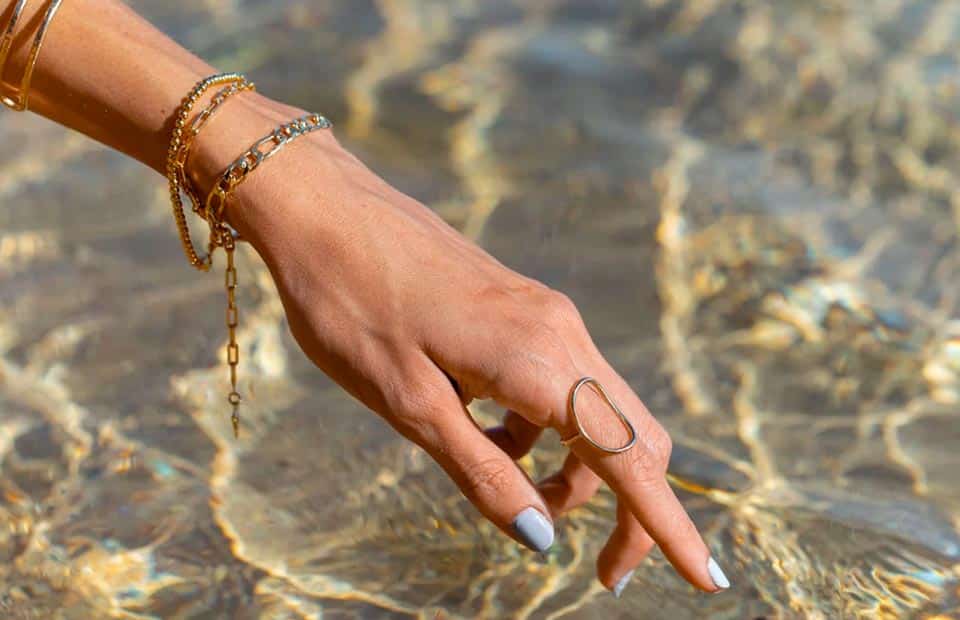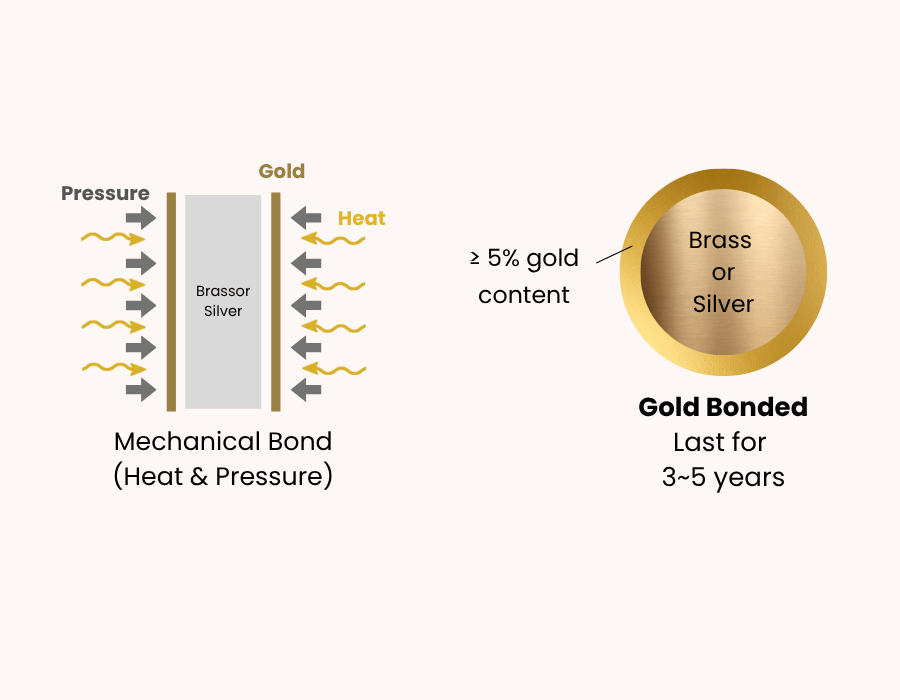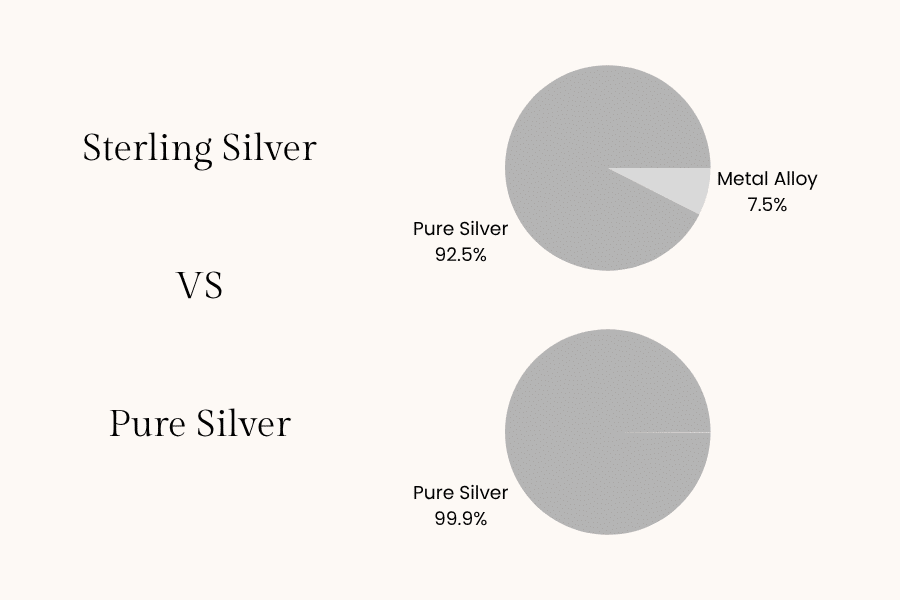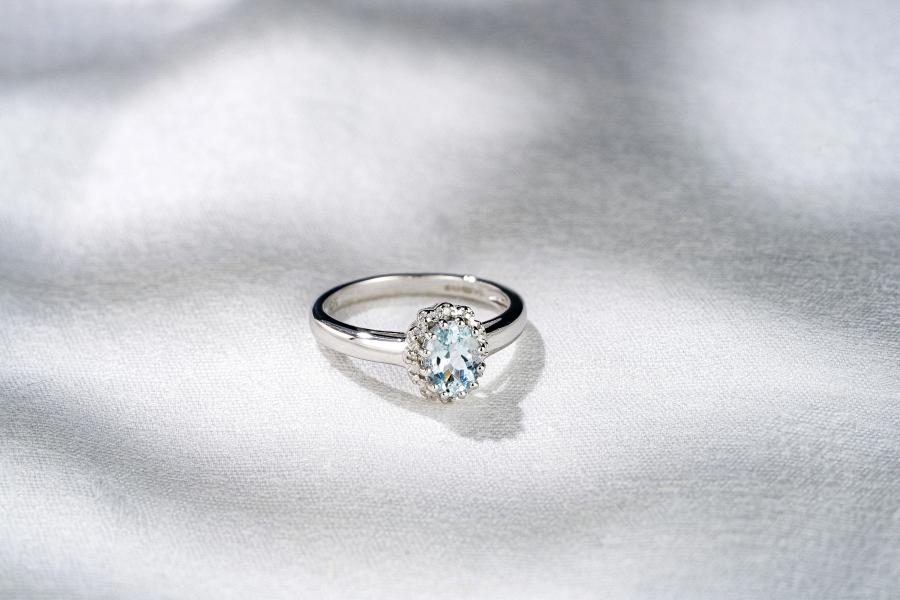The aftermath of the enjoyable seaside experience is that your jewelry might be damaged in the process, especially if it’s made with a material that cannot withstand the ocean.
Even if your jewelry is waterproof, it might not be able to withstand the salt content from sea water, thereby reducing the brilliance and enchanting appearance of the jewelry. Hence, knowing the type of jewelry to use when going to the beach is very important.

In this guide, we will enlighten you on the various types of jewelry that can survive salt water, allowing you to enjoy your next ocean dive without worries.
Does Salt Water Ruin Jewelry?
Saltwater contains salt and several minerals, such as magnesium, sodium chloride, and calcium, which can ruin certain types of jewelry. Salt and these minerals are harsh and capable of tarnishing the overall look of the jewelry, which is why it’s important to use a salt-water-resistant piece when going to the ocean.
These are some of the effects of salt water coming in contact with your jewelry:
- Corrosion: The constituents of salt water can accelerate the corrosion of some types of metals, particularly those that are not resistant to corrosion, such as iron, copper, aluminum, brass, and bronze. Thus, if your jewelry is made of any of these metals, you risk corroding it in the ocean. The ending effect is discoloration and degradation of the jewelry.
- Damage to Gemstones: Some gemstones, especially man-made stones like pearls, opals, turquoise, coral, and amber are more likely to spoil in salt water than others. Also, natural gemstones like diamonds and sapphires can be damaged if they are treated with elements that compromise their strength. This results in discoloration and weakening of the stone structure over time.
- Abrasion: Amongst the many components of salt water are tiny particles like sand and sediment, which can as well damage jewelry pieces, particularly those with intricate or hollow designs. Sand can be trapped inside, resulting in the scratching or loosening of gemstones.
What Jewelry is Safe to Wear in the Ocean?
There are many types of jewelry made with different materials, but only a few can be worn in the ocean without excessive negative effects. They are sterling silver, gold-filled, solid gold, stainless steel, and platinum. They will be discussed below:
Sterling Silver Jewelry with Proper Handling
Sterling silver is an alloy of 92.5% fine silver and 7.5% copper. Sometimes, , often referred to as 925 sterling silver. While fine silver (also called pure silver) is naturally soft and easily scratched, mixing it with copper makes it stronger and more suitable for jewelry.
That said, sterling silver isn’t the best choice for wearing in the ocean. Silver reacts with air and moisture, causing it to turn black or darken quickly. When exposed to saltwater, this tarnishing process accelerates, making the jewelry lose its shine much faster.
To make waterproof silver jewelry, jewelers often add protective layers such as rhodium plating or e-coating. These treatments help shield sterling silver jewelry from corrosion and make it more resistant to ocean exposure. However, even with these protective measures, it’s always best to dry your jewelry thoroughly after swimming to maintain its beauty and longevity.
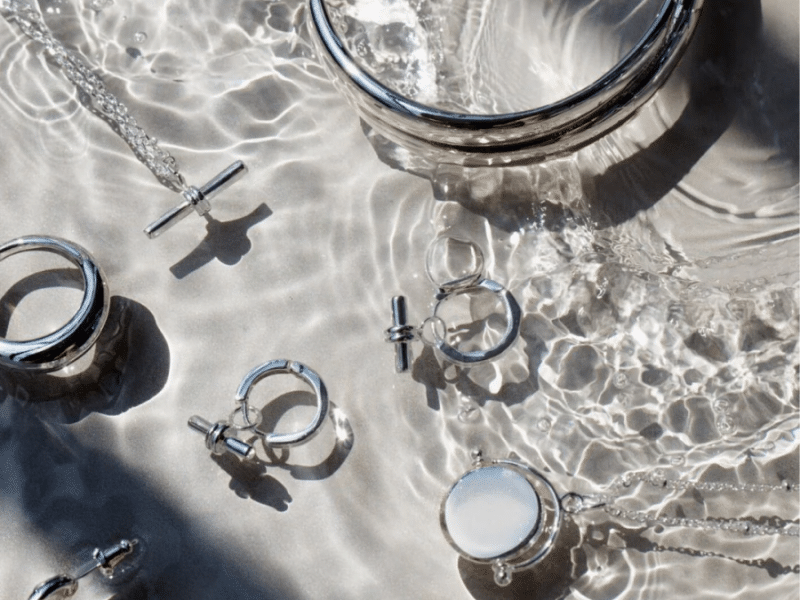
Gold-Filled Jewelry
If you’ve ever wished to get pure gold jewelry, but don’t seem to understand the expensive price tag, gold-filled jewelry is the best solution. Gold-filled jewelry is a better all-rounder alternative to pure gold without breaking the bank.
Unlike sterling silver jewelry, gold-filled jewelry is not composed of alloyed materials. Rather, it’s made by chemically or mechanically bonding a pure gold layer on a base metal like brass. This transfers the characteristics and resistance of the gold to the base metal.
It is harder, more durable, and less expensive, making it a better alternative for solid gold jewelry. Also, it has high resistance to tarnishing and scratch, allowing you to wear it in the ocean.
Generally, gold-filled jewelry is mandated to have at least 5% or 1/20 pure gold by weight. With this, your piece will create a striking balance between beauty and durability. While it’s designed to withstand harsh conditions like salt water, it still radiates elegance and compliments your outfit for any occasion.
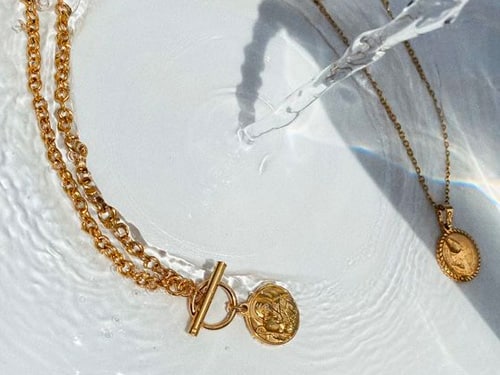
Solid Gold Jewelry
Solid gold is sometimes referred to as pure gold, but they are different. Solid gold is a combination of pure gold with other metals. There are different grades of gold measured by Karatage (K). They are 10K, 14K, 18K, 22K, and 24K. While 10K to 22K are composed of a percentage of pure gold and other metals, 24K is completely pure gold.
- 10K contains 41.7% pure gold and 58.3% other metals.
- 14K contains 58.3% pure gold and 41.7% metals.
- 18K contains 75% pure gold and 25% other metals.
- 22K contains 91.7% pure gold and 8.3% other metals.
- 24K contains 100%/99.9% pure gold.
Solid gold stands out in ocean-proof jewelry. Unlike sterling silver, which tarnishes and darkens in saltwater, solid gold is highly resistant to rust, corrosion, and oxidation. Even after repeated exposure to the ocean, solid gold maintains its luster far better than many other metals.
14K solid gold is the most popular choice for jewelry brands. It strikes the ideal balance between purity, strength, and durability. It’s harder than 18K or 22K gold, meaning it won’t scratch or bend as easily, while still offering a rich, golden shine.
Solid gold also comes in different shades—yellow, white, and rose—so you can customize your ocean-friendly jewelry to your style. To learn more, check out this guide to waterproof gold jewelry.
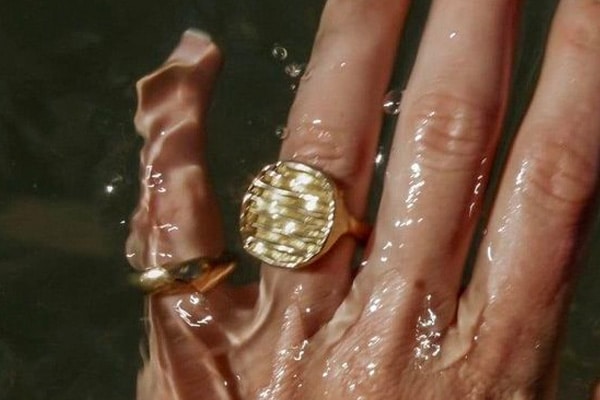
Stainless Steel Jewelry
Made to withstand the harshest conditions, stainless steel jewelry is waterproof and highly resistant to rust, corrosion, and tarnish, even with constant exposure to saltwater or chlorine. It doesn’t fade in the sun, doesn’t react with skin, and doesn’t need babying.
That’s why stainless steel is becoming the top choice for beachgoers, surfers, and swimmers who want durable yet stylish accessories that can keep up with their lifestyle. We also suggest swimwear brands can level up their collections by incorporating stainless steel into their designs. From bikini hardware and clasps to beach-ready body chains and anklets, stainless steel elements add a premium, functional, and ocean-proof touch to your apparel line.
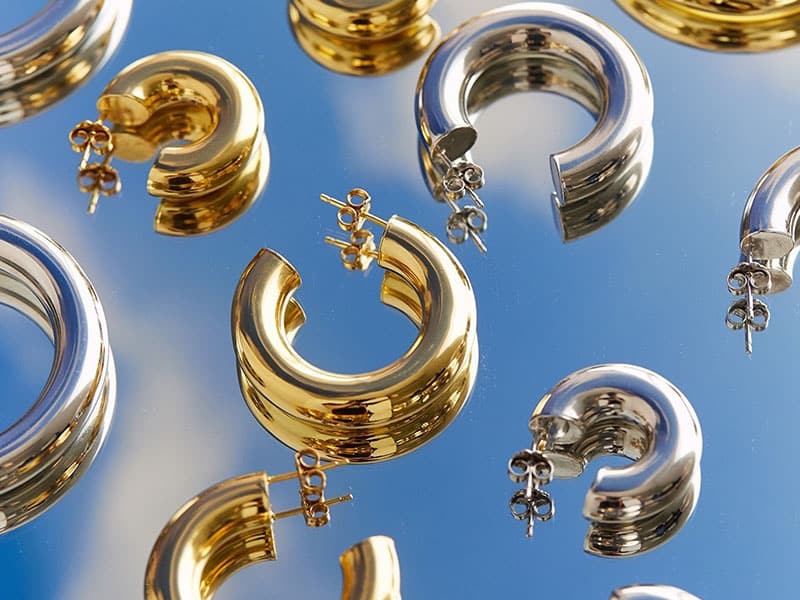
Platinum Jewelry
Platinum is a natural, appealing, and shiny precious metal that’s gradually growing in popularity in the jewelry industry. It’s unique and rare. In fact, it takes almost 10 tons of ore to make 1 ounce of platinum. And it’s so exclusive that only about 90 tons of platinum are manufactured into jewelry every year as compared to gold that uses 2,700 tons. Hence, why it’s very expensive.
In addition to being more exclusive, platinum is stronger and heavier than other metals, making it a preferred choice for use in the ocean, as it has more capacity to withstand saltwater elements. Also, its strength makes it the ideal option for setting gemstones, especially expensive and natural stones like diamonds on engagement rings. The durability of platinum is sometimes used as a symbol of love indicating companionship that will last forever.
Furthermore, platinum is scratch-resistant, which prevents it from tarnishing or losing its sparkle. This metal is used to make different types of jewelry that can be trusted to survive the extreme conditions of the ocean. This includes platinum chains that are more long-lasting than their sterling silver and gold counterparts, as well as high-end wristwatches that are beautiful and heavier than traditional steel cases and bracelets.
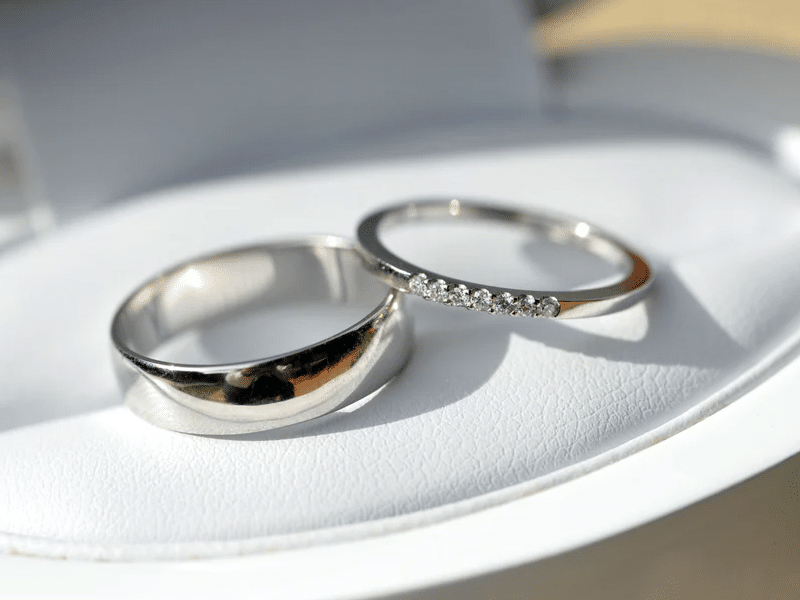
What is the Best Jewelry to Wear in the Ocean?
Looking for the most suitable jewelry to wear in the ocean, these are the 3 recommendations we trust to fulfill your demands:
- Platinum: Amongst all the various jewelry types, those made with platinum are the best due to their inert strength and durability. While platinum jewelry is expensive, its alluring appearance, sophistication, and scratch resistance make it the most ideal option to trust for every ocean dive.
- Gold-Filled: While solid gold is super attractive but very costly, gold-filled steps in the gap. It isn’t just inexpensive, it’s visually appealing, strong, and capable of withstanding tough conditions. Also, it’s very easy to find, as it’s made by heating and bonding molten pure gold on brass. So, in the case that your gold-filled jewelry gives up when exposed to salt water for a very long time, you can easily replace it without breaking the bank.
- Stainless Steel: Stainless steel is an affordable yet reliable jewelry material that’s perfect for wearing in the ocean. It resists rust, fading, and discoloration, making it ideal for beach days, swimming, and active lifestyles. Its durability, low maintenance, and sleek appearance offer a stylish, budget-friendly alternative that doesn’t compromise on performance in harsh environments.
Can You Wear 14K Gold in the Ocean?
Pure gold because of its softness is not suitable for making jewelry pieces that can be worn daily. Hence a professional custom jewelry manufacturer mixes metals with pure gold to produce more durable pieces. However, the more metal components in a jewelry, the less authenticity of the pure gold. This means it won’t shine as bright and elegant as real gold.
14K gold is a mixture of 58.5% pure gold and 41.5% other metals, such as copper, zinc, silver, and nickel. It’s a very popular choice in the fashion and beauty industry because it creates a balance between durability and attractiveness.
Interestingly, salty ocean water has little to no effect on pure gold. But most of the alloyed metals are prone to salt water corrosion. Among the metals added, copper is usually the most vulnerable to corrosion. Therefore, the more copper in your 14K gold, the more risky it is in the ocean.
Can You Wear 18K Gold in the Ocean?
Yes, you can wear 18K gold in the ocean, but with caution.
18K gold is made of 75% pure gold, which is naturally resistant to tarnish and corrosion. However, the remaining 25% is made of alloy metals like copper and silver, which can react with saltwater over time, potentially causing discoloration, dullness, or structural weakening. While short-term exposure is unlikely to cause immediate damage, frequent or prolonged wear in the ocean can reduce the shine and lifespan of your jewelry. To keep your 18K gold looking its best, rinse it with fresh water after swimming and dry it thoroughly.
Is Sterling Silver OK in Salt Water?
To improve its strength and durability, silver is typically alloyed with other metals, forming what’s known as sterling silver. This material is made of 92.5% pure silver and 7.5% other metals, usually copper.
So, can you wear sterling silver in the ocean? Technically, yes. Because copper is prone to corrosion, the larger percentage of pure silver in the composition makes sterling silver capable of withstanding extreme conditions in the ocean. But sterling silver is not 100% safe from salt water, it can darken sooner than normal after being soaked in saltwater for a while.
If you do wear sterling silver in the ocean, be sure to rinse it thoroughly with fresh water afterward and dry it completely to maintain its shine and prevent early tarnish.
Can Stainless Steel Jewelry Go in the Ocean?
Can you wear stainless steel in the ocean? Yes, stainless steel jewelry can absolutely go in the ocean.
Unlike other metals that may rust or discolor in salty conditions, stainless steel maintains its shine and structural integrity even after prolonged exposure to saltwater. This makes it a popular choice for beachgoers, surfers, and swimmers who want worry-free jewelry that can handle ocean adventures without fading, tarnishing, or causing skin irritation. Plus, it’s affordable and low-maintenance—just rinse it with fresh water and you’re good to go.
Key Takeaway
Wearing jewelry in the ocean without worries can be exciting, as your focus will be on celebrating the sea’s beauty and expressing your style. But this can only be achieved by choosing jewelry made with materials that are safe from the consequences of salt water. Some of these materials are platinum, sterling silver(with proper handling), gold-filled, stainless steel and solid gold.
Remember, the ocean is full of treasures and adventurous, your jewelry shouldn’t stop you from having this experience. Contact us today to help you design durable jewelry pieces that will continue to sparkle and last long despite frequent use in the ocean.
